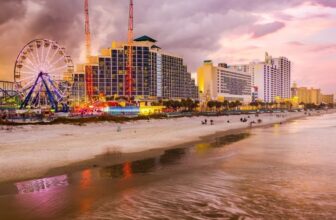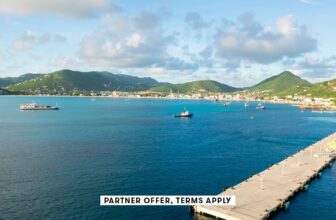[ad_1]
The U.S. can sometimes seem like a blessing and a curse for Paris-based Accor, the hotel conglomerate behind brands like Sofitel and Raffles.
On the one hand, it’s never going to be as big in the U.S. as Marriott, Hilton or even Hyatt. On the other hand, the company is holding onto one of the country’s most well-known luxury hotel brands: Fairmont Hotels & Resorts.
The company’s decision to relocate the headquarters of the Fairmont brand to Dubai earlier this year might seem like a push away from the U.S. and Canada, two countries where the brand has a significant footprint. However, Mark Willis, Fairmont’s CEO, sees plenty of opportunities to further strengthen Fairmont’s grip on North and Central America.
“Here in the U.S., I think there’s a huge opportunity for us to grow the brand, and one of the focuses that I’ll have over the next three to five years will be to grow the footprint of the brand here in the U.S.,” Willis said in an interview with TPG at the recent New York University International Hospitality Investment Conference. “We need to do that in the right way. Its status here in [North and Central America] is such that you can’t just open any Fairmont.”
Willis emphasized the company must be selective about where it puts a Fairmont to retain its luxury status.
Of course, you don’t just move your hotel brand’s headquarters to Dubai because you feel like it. Of the 90 hotels within the Fairmont portfolio, 45 are in North and Central America compared to the 45 properties located elsewhere in the world.
There might be opportunities to expand in the U.S., but it’s clear there’s plenty of runway for the brand to take off around the globe. For now, the immediate list of hotel openings only includes destinations outside the U.S., including Cape Town; Bangkok; Agra, India; Cheshire, England; and Medina, Saudi Arabia.
While highlighting there is still plenty of growth to be had in the U.S., Canada and Central America, Willis noted the Dubai headquarters would be more centrally located within the future portfolio of Fairmont’s 90-and-still-growing hotel count.
“Dubai is a super central location for the brand,” Willis said. “If you’re in New York or Toronto, effectively, you’re very [North and Central America-] centric. Dubai is a super hub into Asia, Europe and indeed [still] has great airlift to get in and out of the U.S. and Canada.”
Sign up for our daily newsletter
The call (and competition) is coming from inside the house
It’s easy to think of Fairmont’s competing luxury brands coming from other companies like Marriott’s Ritz-Carlton or Hilton’s Conrad. However, Accor has more than 40 brands, which means some of Fairmont’s luxury competition comes from within the family.
Don’t get too caught up in that, company leaders say.
Raffles and Orient Express operate in the ultra-luxury sphere, and Sofitel is a “very fun” brand with a nod to French luxury that operates differently than Fairmont, Willis said. Accor’s lifestyle hotel offshoot with Ennismore also has a slate of luxury hotel brands, but it’s hard to say something like a Faena goes head-to-head with Fairmont.
A Fairmont face-lift
Fairmont may be a highly regarded luxury brand, but it can also seem like the spots of a giraffe: No two Fairmonts are alike.
For example, my hometown Fairmont in Boston (which is home to one of my favorite hotel bars, the Oak Long Bar + Kitchen) sits within a historic building nestled among some of the city’s iconic architecture. A stark contrast from the Boston property is the Fairmont in Austin, a towering glass box with a vibrant rooftop pool. Then, of course, there’s the Fairmont in Doha, Qatar, which co-occupies the horn-shaped Katara Towers alongside a Raffles hotel.
There’s a place for all these properties in the Fairmont ecosystem, Willis said, but that doesn’t mean settling for the status quo.
“What we need to make sure we do is continue to look back at the history because that you definitely don’t want to forget, but we also need to look forward,” Willis said. “There’s a lot of effort being put into the brand: how it’s portrayed and how it’s communicated, both the look and feel. I have over 25 renovation projects going on, which is huge. When you’ve got 90 hotels, that’s nearly a third of the portfolio.”
He didn’t divulge much in the way of specifics of what that revamped look or feel of the brand might look like. However, he did indicate the refresh would touch all aspects of the hotel experience: the spa, guest rooms, meeting rooms, event spaces and even the arrival experience.
“A lot of brands have taken the opportunity to reevaluate as they come out of COVID,” Willis said. “For us, it’s a little bit different. When I talk about Fairmont, it’s a full evaluation of where the brand is sitting [and] its positioning.”
One area the Fairmont CEO was willing to share some specifics about was the all-inclusive space, albeit the luxury end of the all-inclusive resort sector. The brand already offers all-inclusive rates at the Fairmont Mayakoba in Mexico.
“All-inclusive, along with lifestyle [hotels], is a huge growing segment,” Willis explained. “Fairmont, the brand, is part of Accor’s all-inclusive [offering], and I think there’s real traction in that as we go forward.”
Keep in mind, Accor’s three brands earmarked for all-inclusive growth — Fairmont, Sofitel and Rixos — are all focused on luxury experiences.
“To take that ethos into a Fairmont all-inclusive property and do it in the right way, especially in the luxury level, I think has huge growth opportunities,” Willis said.
Related reading:
[ad_2]





